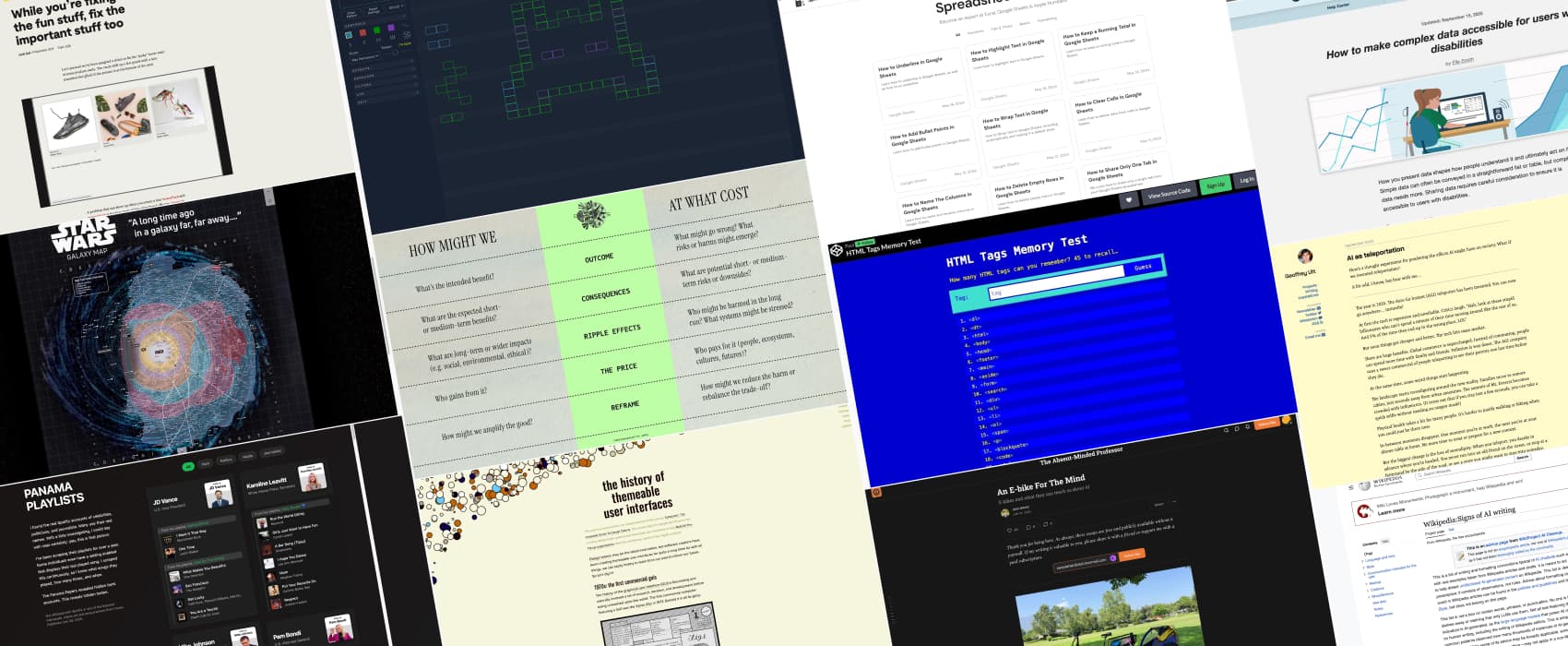
Pixels of the Week – September 21, 2025
Asking "at what cost", a Star Wars map & a fun HTML tags game.
Pixels of the Week is my weekly-ish curated newsletter for designers, UX folks, devs, and anyone building accessible, inclusive, usable (and let’s be honest, awesome) digital products. I share interesting articles, tools, inspiration, and resources I found during the week. This is the archive version. If you’d rather get it straight in your inbox (plus be notified when I publish other articles), subscribe to my newsletter.
Most popular content this week
From “how might we” to “at what cost” (8min) “Moving fast and breaking things is no longer acceptable and as designers, we need to start considering both possibilities and the responsibilities we hold.” Yes, to all of this. Ida Persson presents an interesting framework that you can re-use, to help people ask the big question: “at what cost”. The activity is designed for you to reflect deeply and thoughtfully on an idea, project, or product you’ve worked on or are considering.
Interesting articles that caught my attention
An E-bike For The Mind (10min) What E-bikes can teach us about AI: innovation is a bargain. We need to consider the what is being augmented / amputated. How is the augmentation going to interact with our effort. And why we are taking this choice (values, motivations). I really like this metaphor by Josh Brake (but also I’m biased, I got an ebike too).
The History of Themeable User Interfaces (13min) a lovely history lesson, by Brad Frost, tracing the evolution of themeable user interfaces from the first GUIs to today’s design tokens. Did you know that Mario and Luigi were one of the first themeable UI element? Born from tight technological constraints, they helped pave the way for a whole new era of flexible, customizable design systems.
AI as teleportation (7min) an interesting metaphor: AI is powerful and convenient. But it erases friction that once gave life depth. Sometimes, you want the friction, you want to take the long slow road, because, it brings social interactions. Not all inconvenience is bad: sometimes the journey, not just the result, is what matters.
Curiosity cabinet: non-design/tech rabbit holes I enjoyed
The Star Wars Galaxy an actual map, of that famous galaxy far far away, that’s quite fun to explore.
Inspiration: fun experiments, beautiful art, and great ideas
How many HTML tags can you remember? No cheating! By Paul Foster
Useful tools & resources
Wikipedia:Signs of AI writing an interesting list to help spot if something was written by an AI or not (via cassido’s newsletter)
Panama Playlists can you judge someone from their playlist? The Panam playlist reveals hidden music tastes, from some politicians, journalists and celebrities (based on a year of data scrapping)
Spreadsheet Secrets a list of functions, tips and tricks, to help you become an expert at Excel, Google Sheets and Apple Numbers. Who also works at a bank and really needed this earlier?
Draw Audio: Absolutely Monday procrastination: draw on the art board to create music. I kind of tried to make, sort of space creature, with the random option, it’s not, as bad as I thought it would be.
Tutorials
How to make complex data accessible for users with disabilities (15min) Start with purpose. Don’t show data just to show it. Design for real people, not the “average” user. Use tables, charts, captions, and summaries to give multiple ways in. Accessibility makes data not just readable, but also usable. by Elle Smith
While you’re fixing the fun stuff, fix the important stuff too (10min) how to fix a wonky CSS hover effect, but, also, while you are at it, how to fix the HTML of your card to make it more accessible: “we should be always looking at ways to improve stuff, as we work on it.”. By Andy Bell.
An Accessible Guide to WCAG 3.3.8: Authentication Without Frustration (11min) I think “never block copy pasting” should be tip number one, honestly, so many forms still block it, it’s horrible for accessibility, and annoying for usability. Also, other solutions include going passwordless, using Webauthn with passkeys, rethinking your multi-factor authentication to make it more accessible (for example, offer a copy code option, ensure enough time to copy it, etc.) and handle CAPTCHAs carefully. By Ramona Schwering